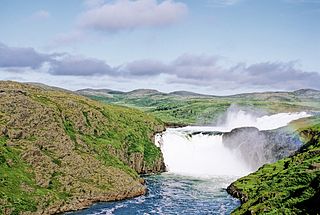 W
WNunavik comprises the northern third of the province of Quebec, Canada in Kativik, part of the Nord-du-Québec region. Covering a land area of 443,684.71 km2 (171,307.62 sq mi) north of the 55th parallel, it is the homeland of the Inuit of Quebec. Almost all of the 13,181 inhabitants of the region, of whom 90% are Inuit, live in fourteen northern villages on the coast of Nunavik and in the Cree reserved land (TC) of Whapmagoostui, near the northern village of Kuujjuarapik.
 W
WThe Arnaud River is a river in Nunavik, Quebec, Canada, flowing from the low plateaux of the Ungava Peninsula through a series of glacial lakes to Ungava Bay. Its mean discharge is approximately 15 km³ per year, but the river flows only in the summer as it is frozen to several metres for the rest of the year. The total length of the river is about 377 kilometres, but there are several main channels in the upper reaches of the river, most of them unnamed and hardly sighted even by the native Inuit.
 W
WThe Caniapiscau River is a tributary of the Koksoak River in Nunavik, Quebec, Canada. In Cree the name of the river means rocky point.
 W
WCharpentier River is a river in northern Quebec, Canada, that flows from Lac Nedlouc for about 125 km (78 mi) northwest to Lake Minto. A rarely paddled river, it flows through very beautiful wilderness tundra & taiga. It has several picturesque waterfalls, namely Chutes de Burin and Chute Bleu. It is one of the main tributaries of the Leaf River.
 W
WThe Great Whale River is a river in Nunavik, Quebec, Canada. It flows from Lac Saint-Luson through Lac Bienville west to Hudson Bay. While lower section of the river has very powerful current, with many waterfalls and rapids, upper section consists of series of lakes interconnected by steep rapids and ledges.
 W
W60°0′14″N 70°26′10″W
 W
WElisapie Isaac is a Canadian Inuk singer-songwriter, broadcaster, documentary filmmaker, and activist. She spent her childhood in Salluit, Nunavik, and moved to Montreal in 1999 to pursue communication studies in order to become a journalist.
 W
WThe Kativik Regional Government encompasses most of the Nunavik region of Quebec. Nunavik is the northern half of the Nord-du-Québec administrative region and includes all the territory north of the 55th parallel. The administrative capital is Kuujjuaq, on the Koksoak River, about 50 kilometres inland from the southern end of the Ungava Bay.
 W
WKativik is a territory equivalent to a regional county municipality (TE) of Quebec, with geographical code 992. Its land area is 443,372.20 km², and its population was 12,090 at the 2011 Census of Canada.
 W
WThe Koksoak River is a river in northern Quebec, Canada, the largest river in the Nunavik region. The Inuit village and region's administrative center Kuujjuaq lies on the shores of the Koksoak, about 50 kilometres (31 mi) south from its mouth.
 W
WThe Kovik River is a river on the Arctic tundra in Nunavik, Quebec, Canada. In some maps and publications name of the river is spelled Kovic.
 W
WThe Little Whale River is a river in Nunavik, Quebec, Canada. With an area of 15,900 square kilometres (6,100 sq mi), it is ranked as the 35th largest river basin in Quebec.
 W
WLiving With Giants is a feature-length documentary directed by Aude Leroux-Lévesque and Sébastien Rist and produced by MC2 Communication Média in 2016. The filmmakers capture the tragic reality of a young Inuit in the Arctic landscapes of Nunavik.
 W
WOkpik's Dream is a Canadian documentary film, released in 2015. The film centres on Harry Okpik, an Inuk man from Quaqtaq, who witnessed a government slaughter of Inuit sled dogs as a child and later lost his leg in a hunting accident, and now prepares to compete as a dog musher in the 600 km Ivakkak sled dog race in Nunavik.
 W
WPayne Lake is a lake on the Ungava Peninsula of northern Quebec, and the main source of the Arnaud River. It lies at an elevation of 130 metres (430 ft) and is 103 kilometres (64 mi) long and 12 kilometres (7.5 mi) wide, covering an area of 513 square kilometres (198 sq mi). The lake is named after Frank F. Payne, an English-born meteorologist who explored and operated a weather station in the Hudson Strait area in the 1880s. The Inuit call the lake Tasirruaq, or the great lake.
 W
WThe Rivière de Puvirnituq is a river in Kativik, Nord-du-Québec, Quebec, Canada. The river flows 389 kilometres (242 mi) from its source at an unnamed lake to Hudson Bay at the village of Puvirnituq. Its watershed encompasses 28,500 square kilometres (11,000 sq mi). The name of the river comes from the Inuktitut "smells like rotten meat."
 W
WThe Rivière aux Mélèzes is a river in Nunavik, Quebec, Canada. It forms the western part of the large basin of the Koksoak River. The other main tributary of the Koksoak is the Caniapiscau River, to the south.
 W
WTursujuq National Park is a National Park of Quebec, Canada. Its creation was announced by the Province of Quebec on December 14, 2012, and officially established on July 18, 2013. Located on the east side of Hudson Bay near the Inuit village of Umiujaq, the park is one of North America's largest, with an area of 26,100 km2. It will be managed by the Kativik Regional Government, which encompasses most of the Nunavik region of Quebec.
 W
WVachon River is a river in the Arctic tundra of Nunavik, Quebec. It originates on Lac Laflamme at 61°21′49″N 73°45′36″W just north of Pingualuit crater and finishes at 60°4′43″N 71°8′59″W where it joins Arnaud/Payne River. It was named after bishop Alexander Vachon (1885–1953), rector of Laval University in 1939 and from 1940 to 1953, archbishop of the diocese of Ottawa, Ontario.